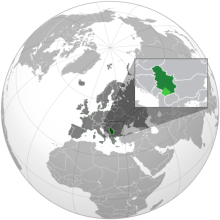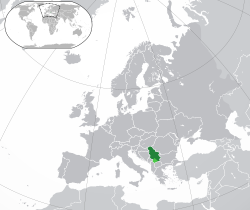Republic of Serbia Република Србија, Republika Srbija (Serbian) | |
|---|---|
| Anthem: Боже правде Bože pravde (English: "God of Justice") | |
Location of Serbia (green) and the claimed but uncontrolled territory of Kosovo (light green) in Europe (dark grey) | |
| Capital and largest city | Belgrade 44°48′N 20°28′E / 44.800°N 20.467°E |
| Official languages | Serbian[a] |
| Ethnic groups (2022; excluding Kosovo) |
|
| Religion (2022; excluding Kosovo) |
|
| Demonym(s) | Serbian |
| Government | Unitary parliamentary republic |
| Aleksandar Vučić | |
| Miloš Vučević | |
| Ana Brnabić | |
| Legislature | National Assembly |
| Establishment history | |
| 780 | |
• Kingdom | 1217 |
• Empire | 1346 |
| 1459–1804 | |
| 1804–1835 | |
| 1815 | |
| 13 July 1878 | |
| 18 March 1882 | |
| 1 December 1918 | |
| 27 April 1992 | |
• Independence restored | 5 June 2006 |
| Area | |
• Total | 88,499 km2 (34,170 sq mi)[2] (111th) |
• Excluding Kosovo | 77,612 km2 (29,966 sq mi)[3] |
| Population | |
• January 2024 estimate | |
• 2022 census | |
• Density | 85/km2 (220.1/sq mi) (130th) |
| GDP (PPP) | 2024 estimate |
• Total | |
• Per capita | |
| GDP (nominal) | 2024 estimate |
• Total | |
• Per capita | |
| Gini (2019) | medium inequality |
| HDI (2022) | very high (65th) |
| Currency | Serbian dinar (RSD) |
| Time zone | UTC+1 (CET) |
• Summer (DST) | UTC+2 (CEST) |
| Calling code | +381 |
| ISO 3166 code | RS |
| Internet TLD | |
Serbia,[c] officially the Republic of Serbia,[d] is a landlocked country at the crossroads of Southeast and Central Europe,[9][10] located in the Balkans and the Pannonian Plain. It borders Hungary to the north, Romania to the northeast, Bulgaria to the southeast, North Macedonia to the south, Croatia and Bosnia and Herzegovina to the west, and Montenegro to the southwest. Serbia claims a border with Albania through the disputed territory of Kosovo. Serbia has about 6.6 million inhabitants, excluding Kosovo. Its capital Belgrade is also the largest city.
Continuously inhabited since the Paleolithic Age, the territory of modern-day Serbia faced Slavic migrations in the 6th century. Several regional states were founded in the early Middle Ages and were at times recognised as tributaries to the Byzantine, Frankish and Hungarian kingdoms. The Serbian Kingdom obtained recognition by the Holy See and Constantinople in 1217, reaching its territorial apex in 1346 as the Serbian Empire. By the mid-16th century, the Ottomans annexed the entirety of modern-day Serbia; their rule was at times interrupted by the Habsburg Empire, which began expanding towards Central Serbia from the end of the 17th century while maintaining a foothold in Vojvodina. In the early 19th century, the Serbian Revolution established the nation-state as the region's first constitutional monarchy, which subsequently expanded its territory.[11] In 1918, in the aftermath of World War I, the Kingdom of Serbia united with the former Habsburg crownland of Vojvodina; later in the same year it joined with other South Slavic nations in the foundation of Yugoslavia, which existed in various political formations until the Yugoslav Wars of the 1990s. During the breakup of Yugoslavia, Serbia formed a union with Montenegro,[12] which was peacefully dissolved in 2006, restoring Serbia's independence as a sovereign state for the first time since 1918.[13] In 2008, representatives of the Assembly of Kosovo unilaterally declared independence, with mixed responses from the international community while Serbia continues to claim it as part of its own sovereign territory.
Serbia is an upper-middle income economy and provides universal health care and free primary and secondary education to its citizens. It is a unitary parliamentary constitutional republic, member of the UN, CoE, OSCE, PfP, BSEC, CEFTA, and is acceding to the WTO. Since 2014, the country has been negotiating its EU accession, with the possibility of joining the European Union by 2030.[14] Serbia formally adheres to the policy of military neutrality.
Cite error: There are <ref group=lower-alpha> tags or {{efn}} templates on this page, but the references will not show without a {{reflist|group=lower-alpha}} template or {{notelist}} template (see the help page).
- ^ a b "Mother tongue, religion and ethnic affiliation". ABOUT CENSUS. Archived from the original on 15 July 2023. Retrieved 10 November 2023.
- ^ Kovačević, Miladin (2023). "Статистички годишњак Републике Србије 2023" [Statistical Yearbook of the Republic of Serbia 2023] (PDF). Statistical Yearbook of Serbia (in Serbian and English) (32). Belgrade: Statistical Office of the Republic of Serbia: 11. ISSN 0354-4206. Archived (PDF) from the original on 5 February 2024. Retrieved 8 December 2023.
- ^ "The World Factbook: Serbia". Central Intelligence Agency. 20 June 2014. Archived from the original on 4 February 2021. Retrieved 18 December 2014.
- ^ "Population". www.stat.gov.rs. Statistical Office of the Republic of Serbia (RZS). Retrieved 9 November 2024.
- ^ "Final results of the Census of Population, Households and Dwellings, 2022". Statistical Office of the Republic of Serbia. 28 April 2023. Archived from the original on 6 January 2024. Retrieved 28 April 2023.
- ^ a b c d "World Economic Outlook Database, October 2024 Edition. (Serbia)". www.imf.org. International Monetary Fund. 22 October 2024. Retrieved 9 November 2024.
- ^ "Gini coefficient of equivalised disposable income – EU-SILC survey". ec.europa.eu. Eurostat. Archived from the original on 20 March 2019. Retrieved 16 December 2020.
- ^ "Human Development Report 2023/24" (PDF). United Nations Development Programme. 13 March 2024. Archived (PDF) from the original on 13 March 2024. Retrieved 13 March 2024.
- ^ "South-Eastern Europe - UNECE". unece.org. United Nations. Retrieved 24 August 2023.
- ^ "Serbia: On the Way to EU Accession". worldbank.org. World Bank. 8 April 2013. Archived from the original on 28 October 2023. Retrieved 24 August 2023.
One particular emphasis has been helping Serbia take advantage of its strategic location in central Europe through investments in transport infrastructure.
- ^ "The Serbian Revolution and the Serbian State". Steven W. Sowards, Michigan State University Libraries. 11 June 2009. Archived from the original on 10 October 2017. Retrieved 28 April 2010.
- ^ "Yugoslav Agreement on Succession Issues (2001)". 3 October 2010. Archived from the original on 26 May 2012. Retrieved 14 June 2012.
- ^ "FR Yugoslavia Investment Profile 2001" (PDF). EBRD Country Promotion Programme. p. 3. Archived from the original (PDF) on 28 September 2011.
- ^ Milovančević, Vojislav (19 September 2023). "EKSKLUZIVNO Francusko-nemački predlog za proširenje EU: Ako ispuni uslove, Srbija bi mogla da postane članica 2030. godine" (in Serbian). Nova.rs. Archived from the original on 20 September 2023. Retrieved 19 September 2023.



